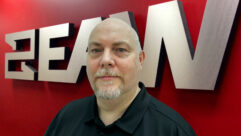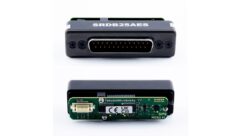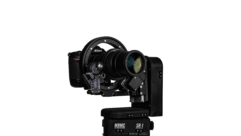Is it P.A. or SR?
Nov 1, 2003 12:00 PM,
Bruce Borgerson
What should you call the audio systems you are designing or installing? Is it public address (P.A.) or sound reinforcement (SR)?
Some say it depends on the technology and capabilities. Others say it depends on the system’s intended use. Some say what you call these systems matters a great deal. Others say the terms are fuzzy and largely interchangeable, so the terminology is irrelevant.
“You say po-tay-to and I say po-tah-to,” says Steve Young, of Atlas Sound, one of a dozen people in the industry — consultants, contractors, and manufacturers — who responded to an informal random survey on the subject. “To be honest, I think the lines are blurred beyond the point of distinct definitions. But if you do make distinctions, we make products that address both.”
That certainly represents a practical working approach to the matter, though other survey respondents insist on defining some concrete separation of the two terms. However, before you sample the variety of views offered, take a quick glance at standard references and historical developments. Is there a quick and easy answer at hand?
Apparently not. Web-based references and glossaries fail to shed much light on the subject. For example, Rane’s comprehensive Professional Audio Reference lacks definitions for either term, perhaps assuming both are insufficiently technical in nature. Next, using the Web’s OneLook metasearch of dictionaries and glossaries, I did uncover ten definitions for “public-address system.” Typical was the entry from the Merriam-Webster’s site: “An apparatus including a microphone and loudspeakers used for broadcasting (as to an audience in an auditorium).” Interestingly, the definition was first accepted into the Merriam-Webster’s lexicon quite early: 1923.
A similar search for “sound reinforcement system” brought nothing. However, dropping “system” brought two entries for “sound reinforcement,” both from glossaries of theatrical terms. Unfortunately, the narrow definitions offered (for example, “The aim is to present the listener with an amplified but natural sound”) failed to adequately clarify the term when applied to a broader range of commercial and industrial applications.
Could a quick look at the history of the terms reveal something? A round of Web searches affixing “history” to both terms reveals that, not surprisingly, the term public address extends further back and is more commonly applied. The fascinating History of Public Address site (www.historyofpa.co.uk) uses “P.A.” exclusively to describe the earliest systems, dating all the way back to the San Francisco voice-only debut of Magnavox in 1915. But the site also notes that in 1925, a Marconi system set up for the Royal Air Force Pageant at Hendon not only amplified the voice of the commentator but also, between events, “the music of the band could be distributed throughout the whole system.” Was that the dawn of sound reinforcement? Certainly not on the basis of (pardon the pun) bandwidth!
Lacking access to original documents, I found it hard to track the gradual development of the terms over the decades. But for these purposes, what matters is the way they are being used today. What exactly is meant when these two terms are applied? What specific criteria distinguish the two?
According to the results of the survey, those who contend that P.A. and SR have distinct meanings can be divided broadly into two camps. At the risk of oversimplification, one group maintains that the difference is basically a matter of technical capabilities, primarily system bandwidth but also, in some applications, output level. Another group tilts toward distinctions based on intended use, particularly in regard to amplifying sounds in conjunction with some kind of live event.
Staking out the first position is consultant R. Bob Adams of Hoover and Keith in Houston. “It is basically a matter of bandwidth,” he says. “In the minds of most consultants, a P.A. system is a voice-only projection system with limited bandwidth, one that is designed to pierce certain environments with necessary information. By default, a sound reinforcement system has wider bandwidth, and it most often has multiple uses, some of which normally involve music.”
Ron Baker, a principal of Wrightson, Johnson, Haddon, and Williams (WJHW) in Dallas, generally concurs on the issue. “Public address is a more band-limited, voice grade system. It has the primary, if not exclusive, purpose of conveying announcements or information to a group of listeners.” Because WJHW is known for designing stadium and arena systems, you might assume that P.A. would be a commonly used term around the office. However, according to Baker, “P.A. is a term we don’t use much anymore. We tend to refer to what we do as the reinforcement system or just the sound system. For some of us, P.A. carries a perspective that might be overly limiting.”
Design engineer George Clark of Clark ProMedia in Cumming, Georgia, focuses primarily on church and auditorium systems, yet he also leans toward the bandwidth-based definitions. “In our market, sound reinforcement systems are high fidelity, whereas P.A. systems just get voice information out,” he says. “P.A. tends to be band limited, with no subwoofers, and intelligibility is the main concern.”
Kelly Prince of system integrator ProSound in Orlando, Florida, has applied his design work to arenas and churches, and he agrees that P.A. is “something like your high school gymnasium or a classroom sound system, whereas a sound reinforcement system provides full bandwidth for music reproduction.” But with the increasing infiltration of music program into all kinds of systems, he notes that strictly defined P.A. systems “are few in number these days, except for industrial applications.”
Finally, speaking up for the manufacturers, JBL Professional’s vice president of marketing, Mark Gander, defines sound reinforcement as “high fidelity with increased dynamic range and full-frequency output of an audio program.” P.A., on the other hand, he describes simply as “intelligible communication to an audience.”
WHAT’S THE USE?
After moving through a middle ground of “both/and” definitions, we come to a contrasting group of survey respondents who tend to focus on the actual or intended use of an audio system. The most thoughtful treatise elucidating this viewpoint comes from St. Louis-based system designer and alignment specialist Bob McCarthy.
“Sound reinforcement connotes that an acoustical event is occurring that is then being projected through a sound system and thereby reaches a larger audience,” he says, adding that the SR system therefore may be “full range for music or vocal range only.” In contrast, he defines P.A. as sound that “does not necessarily have a link to a live event or being in real time. P.A. can appear to be linked to an image, such as video screen, but there is no live component.” Once again, he says that the definition is independent of system bandwidth: “There are two frequency ranges for either SR or P.A.: full range or voice only.”
Bob Lee of QSC Audio sounds a note of general agreement. “Sound reinforcement systems amplify the less powerful sound of what we wish to hear or would be able to hear in a more intimate setting,” he says, whereas the public-address system merely “communicates announcements to a gathering of people, providing information but not entertainment or aesthetics.”
Lee goes on to say that “the line between the two is blurry.” As an example, he cites the ’70s rock bands that starting out using Shure Vocalmaster systems. “The mics went to the P.A., and the instruments to their own amps,” he says. “But as it became more commonplace [normally after upgrading to full-range loudspeakers] for instruments to be supported by the P.A. system and the overall sound became dictated more by the person at the mixing console, the concept migrated more toward sound reinforcement.”
Lee ushers us into a middle ground, where survey respondents seemed to be split between the “bandwidth” and “intended use” points of view.
Kelvin Draughon of contractor/integrator Draughon Brothers in Fayetteville, North Carolina, balances the two neatly. He defines a sound reinforcement system as one that would be “used to amplify an existing source of music” such as a band or live orchestra, whereas P.A. would be a system “set up specifically for a speaker to address an audience.” But he then notes that “a sound reinforcement system would need far greater bandwidth, and depending on the program material, it could require quite a bit more output capability.”
Craig Janssen, principal of Acoustic Dimensions in Dallas, elaborates on the same overall theme from his perspective as a designer of large-scale systems. “In our market, P.A. is what you would hear in an airport or train station,” he says. “The dividing line might be between where you are simply communicating articulate information and where, after a gray area, you move into creating a sound environment or providing entertainment. Yes, to some extent it’s a matter of bandwidth, on a technical level. But from our point of view as consultants, it’s more about intended purpose.”
With those varying definitions in mind, how do you apply the terms SR and P.A. in specific applications? The first example, systems for major-league sports stadiums and arenas, sparked the most controversy. Should such a system be labeled P.A. or SR?
“I would call it P.A.,” says McCarthy. “It can be high-power, full range P.A., but there is no linked sonic image.” From his point of view, it can’t qualify as sound reinforcement because “the announcer in the booth is acoustically and visually isolated, and the rest [of the program] is library or video soundtrack playback.”
Draughon concurs, noting that the principal intended use is to play incidental music and announce scores. The exception would be if the installed system were used exclusively “to reinforce Aerosmith doing the halftime show, in which case we hope the designer took into account the needed headroom, duty cycle, and output capability.”
Clark also casts a vote for the P.A. designation. “I would consider that P.A., though high-quality P.A.,” he says. Hedging his bets on the subject is Gander, who says, “It depends on the intent and scope of performance in the design.” He notes that new sports venue systems can “compete with home and commercial theaters and even rock concert levels” and that “a high-quality SR system with full coverage to every seat can supersede the need for a P.A. system.”
Adams plants his feet firmly on the SR side of the fence. “That’s sound reinforcement, absolutely sound reinforcement,” he says. “The expectations are to play music regularly and have people sing over them while meeting an elevated expectation for quality sound.”
As already noted, the term sound reinforcement is pretty much the norm at WJHW, where Baker and his colleagues specialize in systems for sports facilities. “All the systems are expected to do high-quality music,” he says. “Generally, in an outdoor stadium, we try to get down to 45 to 50 Hz on the low end and upwards of 12 kHz on the high end. The distances involved tend to restrict going much higher, due to air loss.”
Janssen, who also has many sports venue designs to his credit, points out that all such systems are properly called SR, even under the broader definition. “At the beginning of the game, you have the national anthem. It’s almost always live musical event, so that makes it by definition a sound reinforcement application, even if just for those few minutes.”
Janssen further points out that most of the actual in-use time for such systems is now devoted to music programming. “If you look at the program from the beginning of the game to the end, I would bet that less than 20 percent of the use is actually live announcements from the booth. The vast majority of source material is video soundtracks, pregame music, punch hits, and sound effects. Yes, the announcer has to be intelligible, but a good reinforcement system will almost by definition work as a P.A.”
Another application, sounds systems for worship, has experienced a similar transformation in recent years. Not long ago, church audio systems were strictly for voice reinforcement, and certainly clear voice reproduction remains a crucial consideration. Yet in this case, nearly all survey respondents agreed that there the term P.A. is outmoded, even though many (if not most) users inside the churches still cling to it. These are now universally seen as sound reinforcement systems.
“That’s SR all the way and scarcely differs from concert mixing, except that people want to hear the words,” says McCarthy. Adams says it’s “totally sound reinforcement here,” and Clark assumes the same with every design. “I would never do a system without multiple subwoofers,” he says. “We put a lot of emphasis on quality and clarity on the music end, and the spoken word usually takes care of itself.”
Janssen concurs and points out an important distinction even when spoken word remains the overriding concern, such as in traditional Catholic churches: “You want a much different voice quality than you would accept in an airport or industrial setting. Here you need a warm richness, a feeling of hearing the speaker without intervening technology, and a strong localization, all of which doesn’t really matter in more straightforward P.A. applications.”
CHICKEN OR THE EGG?
All of those observations bring me to yet another fork in the road. Is P.A. then a subset of sound reinforcement, at least in some applications? Or are there also instances in which, in the same facility, there are separate but distinct P.A. and SR systems?
If you take the “intended use” viewpoint, a sound reinforcement system can double as a P.A. Draughon, who also provides touring rentals, points out that he usually send out his 84-box rig for rock ‘n’ roll sound reinforcement, but when the president needed to address 10,000 troops at a military base, the same system was pressed into duty as P.A.
By the same token, church and stadium systems must fulfill both roles, though usually only minutes or seconds apart. In this situation, the double-duty differentiation is largely at the front end of the system. Clark finds that he can accomplish the P.A. role (if you define it as such) in churches by careful attention to microphone selection and mic channel equalization. In stadium applications, Baker encounters an even greater challenge in combining the two: “The tonal combination, or spectral content, that is desirable for music can be quite detrimental to clear intelligible speech. As a result, we almost always have separate and specific signal processing available for the announcers.”
Other respondents point out another way of looking at it. In these same two applications, you can have separate, clearly defined P.A. and SR systems. McCarthy recalls doing the SIM System alignment at a new California concert hall that had both. “Since it is a symphony hall, it needed a P.A. announce system that is essentially invisible to serve the classical events. But it also has a high-power SR system that is flown for events that need it.” Larry Italia, general manager of Yamaha’s commercial audio systems division, points out that the same can apply to churches. “The main clusters in the sanctuary are SR and used for both voice and music reproduction,” he says, “but a distributed system for the narthex, classrooms, and cry rooms could be described as P.A.”
What if the church youth group’s rock band has a portable system down in the basement? What do we call that? Woe is us! Assuming it’s a higher-quality, broad-bandwidth system that amplifies a live event, then from all I’ve established so far, it should be SR. But in the musical instrument market where it likely came from, use of the term P.A. system for such gear remains essentially universal.
So where does that leave you? Dazed and confused, along with Led Zeppelin? Not entirely. At least at the extremes of usage, there seems to be an emerging consensus.
Adams speaks for a majority when he categorizes systems such as those used in “an industrial environment where you have extremely high ambient noise levels” strictly as P.A. and further maintains that systems such as those in airports, which aspire to more natural reproduction of the human voice, would qualify only as “quality P.A.” Beyond that, he says, “if there’s any background music involved, it goes beyond my strict definition of P.A.”
At the other extreme, none would argue that the system used at a Luciano Pavarotti concert is clearly sound reinforcement.
In between is a state of flux where, curiously, the trend toward a more sound reinforcement-oriented approach is pushing traditional P.A. upmarket. According to Young, “In many commercial applications with both office and warehouses, we are being asked to bring the music out into the warehouse, as well, and that has been a factor in product development as we move more toward higher fidelity in our all-in-one packages.”
Italia neatly sums up the current situation. When asked how the terms have evolved over the years, he says, “Confusingly.” He claims that both have become “fairly generic and inclusive,” and the terms seem to be “interchangeable for many of our customers.” Although he steers toward defining P.A. as “paging-type systems that are a type of SR system,” in the end, he says, “All such characterizations are my own opinion, so there may even be disagreement among my own staff.”
Certainly, he’s not alone. Fortunately, his company seems to be carrying on quite successfully despite any internal semantic inconsistencies, and that seems to apply to the industry as a whole. Nevertheless, if everyone exercises more precision in the use of the two terms, perhaps the slowly emerging distinctions will further solidify during the years to come.
Bruce Borgersonis principal of Wavelength Communications, a consulting firm in Ashland, Oregon. His 30-year audio career spans live sound mixing, system installation, studio recording, and equipment marketing.










